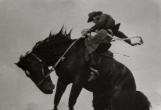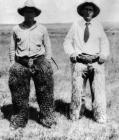14
Bronc riding was standardized with the introduction of an Association Saddle. The saddle had a modified Tipton tree."Before they had the Association saddle every rider used his own, and they had all sorts of tricks, like wetting the leather. When they adopted an Association saddle the Club at Wood Mountain bought two or three and the cowboys had to use them. There wasn't a choice."
-Gene Anderson
16
The Rodeo Committee adopted the rules of the Stampede Managers Association and followed a rule book to provide guidelines for the cowboys and judges."A rider must give a fair saddling as to placing the saddle, cinching etc. Rider must leave the starting place with both feet in the stirrups and both feet against the horse's shoulders and begin scratching the moment the horse leaves. Rider must scratch forward the first five jumps and then behind."
- Rodeo Rule Book
18
For riding events there were four judges - one on foot at the chute, and three mounted on horses. The ride was over when the rear judge blew a whistle at his own discretion. The time was not standardized.20
By the mid-1920's stock contractors were supplying livestock for the competitions.Most of the horses were wild horses from the ranches at Wood Mountain.
"A wild horse, you never knew what they were going to do, not the same thing twice. The worst thing about wild horses was they fell a lot more. You had to be prepared for other things besides just riding. Lots of good riders learned on wild horses." -Gene Anderson
22
Among the first stock contractors at Wood Mountain was Jimmy Ogle."Most of my young life was spent riding horseback as I used to ride with the round-up outfits and my job was to look after the saddle horses. We ran from 1000 to 1200 horses and our range extended all the way from here(Wood Mountain) to where Mankota is now. When I was twelve I graduated into a man's job and joined the other fellows in rounding up the horses."
- James Ogle
24
Horse ranchers often brought their wildest broncs to the rodeo to see if any of the cowboys could ride them. One such bronc was Too High, a saddle horse that turned wild again. Too High became known at rodeos across southern Saskatchewan."One of my greatest thrills was when I became the first man to ride the famous bucking horse Too High. I rode him for about six jumps and then I pulled leather to save myself from being bucked off."
- Jim Lethbridge
26
A holding corral was built inside the race track and two sets of shotgun chutes were constructed. The broncs were saddled and the riders mounted up in the chutes. The gates opened to both sides of the rider ."When I was a little older I used to do a little rodeoing, steer roping, calf roping and I used to ride a few broncs too, but I had enough of them at home.
- Elmer Lamb Jr.






